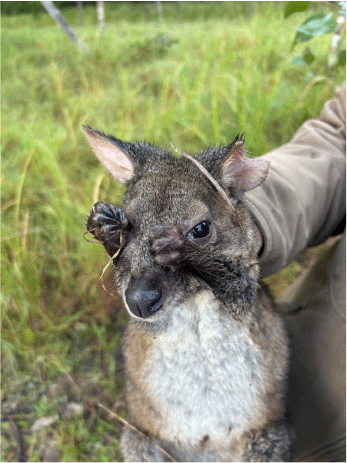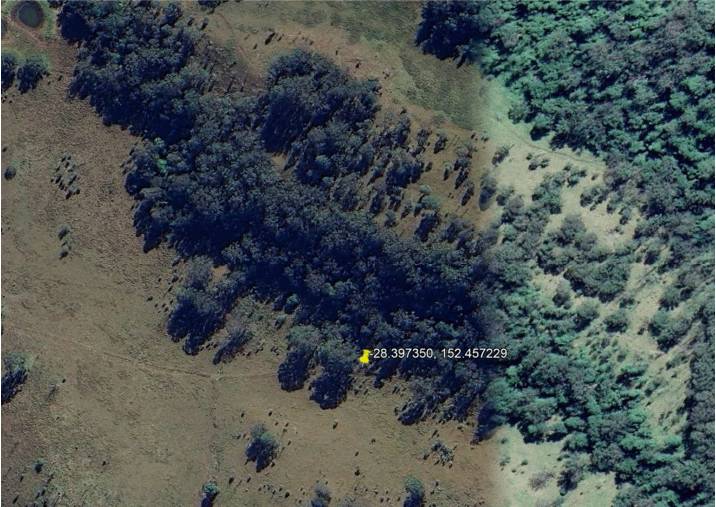Most-northern record of parma wallaby (Notamacropus parma)
Paul D. Meek A B * , Lucy Collingridge C , Jakub Juszczak D , Elly Gooch B and Peter J. S. Fleming B E
B E
A
B
C
D
E
Abstract
We report on a new northern record of the parma wallaby (Notamacropus parma). This animal was captured and subsequently released during a free-ranging dog trapping and collaring program in agricultural land north of Tooloom National Park, New South Wales (NSW), Australia. The parma wallaby can be difficult to identify where there are sympatric wallabies and pademelons, especially on camera-trap images. While research is underway to better understand the occurrence of this species, its distribution is not accurately known. This incidental detection has extended the known range of the parma wallaby in NSW and accords with the modelled distribution of the species.
Keywords: capture and release, distribution, foot-hold trap, Macropodidae, non-target, range confirmation, sympatric, threatened species.
Introduction
Species conservation efforts are most effective where managers have an understanding of species ecology, their threats and distribution. The edge of the distribution is important because it is the point where an ‘individual may fail to reproduce itself’ and may identify where species-limiting factors occur (Caughley and Sinclair 1994). This is particularly important for threatened species with limited distribution and discrete habitat requirements. The parma wallaby (Notamacropus parma Waterhouse, 1846) is a small, threatened macropod found in south-eastern Australia, but its actual distribution is poorly understood (Maynes 1977), which has hindered the study of its ecology in the wild (Maynes 1973; Read and Fox 1991). In recent years, the deployment of camera traps has seen a rapid increase in the detection of small macropods, although accurate identification of parma wallabies is difficult where red-necked and red-legged pademelons co-exist (Maynes 1974). Despite these challenges, camera trap detections have increased in New South Wales (NSW) (Goldingay 2024a, 2024b), which is now improving our understanding of the ecology of the species in the wild and its potential threats and preferred habitat (Hayward et al. 2022).
The predicted distribution of parma wallabies extends through north-eastern NSW and just into southern Queensland (Hayward et al. 2022). The most-northern record of a parma wallaby is from a camera trap identification slightly west of Old Koreelah in Koreelah National Park, collected during the Wild Count Project in 2012 (−28.4161, 152.35359) (Atlas of Living Australia). Identification was confirmed by Alison Foster on the basis of comparisons with pademelons (Thylogale spp.) and parma wallaby distinguishing features such as equal head–body to tail ratio, dorsal grey-black spinal mid-strip and visible white marking on the upper cheek, as described by Maynes (1974) (A. Foster, pers. comm. 2025). There has also been an unconfirmed but likely camera trap detection in another part of the Park (D. McHugh, pers. com. 2025). Both add weight to the predicted modelling of suitable habitat (Hayward et al. 2022) in the Scenic Rim landscape. Although our capture was unintentional and rare during a wild dog (Canis familiaris) collaring program, camera trapping data will be closely scrutinised to further elucidate their occurrence in the area.
This study describes a new northern record of the parma wallaby from agricultural land north of Tooloom National Park, NSW. This animal was captured and released during a free-ranging dog trapping and collaring program.
Method
As a part of a free-living dog trapping and collaring project (Eyes on the Rim project) in farmland near Old Koreelah in northern NSW, Victor #3 (two spring), soft-jawed, foot-hold traps were set with canid lures. To minimise injury during capture and enable continued blood flow within a captured appendage, the traps have off-set, rubber-padded jaws and no teeth (Meek et al. 1995). Traps were staked to prevent trapped animals from injury during restraint by inhibiting their ability to build momentum while trying to escape. These trap sets, while targeting wild canids, also minimise the chance of capture injury to non-target fauna that might be accidentally caught (Meek et al. 1995; Fleming et al. 1998). According to best practice (Meek et al. 2020, 2022) and animal ethics approvals, traps were checked daily each morning and removed at the end of the trapping session.
Results and discussion
During the early morning trap check of the 23 April 2025, an adult female parma wallaby (Fig. 1) was found in a staked foot-hold trap at location −28.397350, 152.457229 (Fig. 2). The animal was promptly restrained and removed from the trap. The captured rear leg was inspected for lacerations, oedema or broken bones and there was no evidence of any injury. DNA was not collected to minimise handling time and distress to the animal. There was a healed, pre-existing injury to the left ear (Fig. 1), but no other injuries or ectoparasites were evident. The pouch and surrounding trap areas were checked, but there was no sign of pouch young or evidence of lactation. After photography and a welfare check, the animal was released. It displayed a normal gait when hopping away into the forest remnant.
Female parma wallaby captured in a rubber jawed foot-hold trap in farmland near Old Koreelah, north-eastern NSW. Note pre-existing injury to its left ear.

Capture site, showing the agricultural track, open agricultural landscape and adjacent forest remnant (image Google Earth).

During handling at the trap site, the macropod was identified by the capture team as a parma wallaby. Red-necked pademelon (T. thetis) and red-legged pademelon (T. stigmatica) can co-occur with parma wallaby; so, to further confirm the identification of the species, we scrutinised macropod images from a camera trap array deployed nearby for the Eyes on the Rim project.
The animal was captured beside an agricultural track near to remnant wet sclerophyll forest but in the open grassed paddock (Fig. 2). Read and Fox (1991) recorded parma wallabies grazing on grasses on roadsides in logged forests and Vernes and Cooper (2007) on roads close to swamps, but ours is the first confirmed record we could find of a parma wallaby foraging in an agricultural paddock, albeit in the ecotone with a forested area. Three historical trapping records of parma wallaby west of Coffs Harbour have been reported in farmland (cited in Maynes 1977), although no specific site details were provided.
This capture is the most-northern record of a parma wallaby and its occurrence at this site supports the predicted habitat modelling provided by Hayward et al. (2022). The closest confirmed record is ~10 km west-south-west in Koreelah National Park previously discussed (Hayward et al. 2022). It is also evidence that this species is not solely a rainforest/forest dweller and can sometimes be found in open grassed paddocks. Importantly, despite the unexpected and accidental capture of the animal in a foot-hold trap set for a wild canid, there were no injuries sustained, providing further proof of the humaneness of soft-jawed foot-hold traps on non-target animals (Meek et al. 2018; Allen et al. 2022).
This record together with camera trap records from the site, including adjacent Taloom National Park and others within 10 km, represent the most-northern records of the species, providing important information to help design conservation practice. It is also important to report that parma wallabies are also utilising agricultural habitats. Camera trap research by these authors will continue to elucidate the local distribution of parma wallaby in the Koreelah district, and we will contribute our findings to current parma wallaby research and management.
Declaration of funding
Funding for the project was provided by NSW Department of Primary Industry and Regional Development and the Centre for Invasive Species Solutions and National Wild Dog Action Plan.
Acknowledgements
Thanks go to AP for permitting us to set traps for free-living dogs on his property. This research was conducted under Animal Ethics Approval OAEC-0640.
References
Allen, B. L., Ballard, G. A., Fleming, P. S., Meek, P. D., and Smith, D. (2022). Improving Animal Welfare Outcomes for Live-Trapped Terrestrial Mammals in Australia. In ‘Mammal Trapping: Wildlife Management, Animal Welfare and International Standards’. (Ed. G. Proulx) pp. 97–120. (Alpha Wildlife Publications: AB, Canada)
Fleming, P. J. S., Allen, L. R., Berghout, M. J., Meek, P. D., Pavlov, P. M., Stevens, P., Strong, K., Thompson, J. A., and Thomson, P. C. (1998). The performance of wild-canid traps in Australia: efficiency, selectivity and trap-related injuries. Wildlife Research 25, 327-338.
| Crossref | Google Scholar |
Goldingay, R. L. (2024a). Anatomy of a post-wildfire recovery: responses of mammals to a Black Summer wildfire in a fox-free landscape. Forest Ecology and Management 569, 122205.
| Crossref | Google Scholar |
Goldingay, R. L. (2024b). The influence of bait and camera type on detection of a spectrum of medium-sized Australian mammals. Australian Mammalogy 46, AM23020.
| Crossref | Google Scholar |
Hayward, M. W., Vernes, K., Ballard, G., Budden, M., Clulow, J., Dooley, E., Fleming, P. J., Griffin, A., Law, B., Lees, D., Meek, P. D., Meyer, N., and Tuckey, K. (2022). Conservation case study: basing IUCN Red List status assessments on an absence of knowledge: the case of the parma wallaby (Notomacropus parma). In ‘Imperiled: The Encyclopedia of Conservation’ (Eds D. A. DellaSala and M.I. Goldstein) pp 324–329.
Maynes, G. M. (1973). Reproduction in the parma wallaby, Macropus parma, Waterhouse. Australian Journal of Zoology 21, 331-351.
| Crossref | Google Scholar | PubMed |
Maynes, G. (1974). Occurence and field recognition of Macropus parma. Australian Zoologist 18, 72-87.
| Google Scholar |
Maynes, G. (1977). Distribution and aspects of the biology of the parma Wallaby, Macropus parma, in New South Wales. Wildlife Research 4, 109-125.
| Crossref | Google Scholar |
Meek, P. D., Jenkins, D., Morris, B., Ardler, A., and Hawksby, R. (1995). Use of two humane leg-hold traps for catching pest species. Wildlife Research 22, 733-739.
| Crossref | Google Scholar |
Meek, P. D., Ballard, G. A., and Fleming, P. J. S. (2018). Techniques and practices of Australian pest animal trappers. Pacific Conservation Biology 25, 257-265.
| Crossref | Google Scholar |
Meek, P. D., Ballard, G. A., Mifsud, G., and Fleming, P. J. S. (2022). Foothold trapping for predators: Australia’s history, present and a future pathway for humane use. In ‘Mammal Trapping: Wildlife Management, Animal Welfare and International Standards. Vol. 5’. (Ed. G. Proulx) pp. 81–96. (Alpha Wildlife Publications: AB, Canada)
Read, D., and Fox, B. (1991). Assessing the habitat of the parma wallaby, Macropus parma (Marsupialia: Macropodidae). Wildlife Research 18, 469-477.
| Crossref | Google Scholar |
Vernes, K., and Cooper, T. (2007). Association of parma wallabies (Macropus parma) with sedge swamps in Gibraltar Range National Park. Australian Mammalogy 29, 111-113.
| Crossref | Google Scholar |


